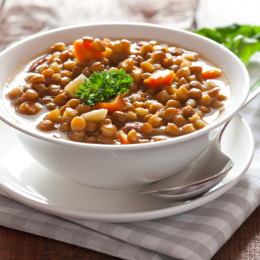Dos and Don’ts of the DASH Diet for Older Adults
This healthy eating plan is one of the best ways to lower your blood pressure. Here’s how to get the most from it in your 60s, 70s and beyond.

Do you have high blood pressure? There’s a good chance you’re already on the DASH diet — or your doctor has encouraged you to start it. That’s a smart health move, since this expert-backed eating plan is a key tool for lowering high blood pressure.
Your risk for this condition, also known as hypertension, goes up as you age. Nearly 75% of adults over the age of 60 have high blood pressure, according to the Centers for Disease Control and Prevention (CDC).
DASH, which stands for Dietary Approaches to Stop Hypertension, focuses on the foods you can eat, not the ones you shouldn’t. The plan includes plenty of fruits and vegetables, whole grains, lean protein (fish, poultry), beans, nuts and low-fat dairy. You limit sodium, added sugar and saturated fat. It’s easy to follow, flexible and delicious.
“Many seniors are pleasantly surprised by the variety and flavorfulness of meals on the DASH diet,” says Angel Planells, R.D.N. He’s a registered dietitian nutritionist based in Seattle, and a spokesperson for the Academy of Nutrition and Dietetics.
Plus, the plan has heart-healthy benefits beyond controlling blood pressure. Studies show DASH can help people reduce the risk of heart disease and stroke, improve cholesterol levels and lose weight.
Ready to get the most out of the DASH diet? Here are some dos and don’ts to help you navigate this popular program.
Healthy eating and fitness go together! SilverSneakers classes and events are happening right now at participating gyms, online through SilverSneakers LIVE, and at community centers near you. Activate your free online account to get started.
Do: Start Small and Ramp Up Over Time
Just getting started with DASH? It can be tempting to overhaul your entire diet overnight. But your chances of success go up if you take it a few steps at a time, says Planells. Look at your usual patterns and make small changes that can get you moving in the right direction. Some to try:
- Add a serving of vegetables at lunch and dinner.
- Add fruit to your breakfast or lunch.
- Have a healthy afternoon snack instead of a sweet one.
- Swap out fatty meat at dinner for chicken or seafood.
- Try seasoning foods without salt by using herbs, spices or lemon juice.
Every week, review the changes you made. Then choose a new part of the DASH diet to try in the seven days ahead. Soon, you’ll be reaping the benefits of the plan.
Recommended reading: Healthy Heart Challenge: A Day on the DASH Diet
Do: Be Mindful of Hidden Sodium
Reducing your sodium intake can help lower blood pressure. The DASH diet limits sodium to about one teaspoon a day, or 2,300 milligrams. Problem is, most of us take in much more than that without even knowing it.
The average American eats more than 3,400 milligrams of sodium a day, according to the CDC. And most of it comes from packaged and restaurant food, not your kitchen salt shaker. Some sneaky sources include bread, pizza, cold cuts and soups.
Two tips that can help you cut back:
- At the grocery store, compare Nutrition Facts labels and choose items with the lowest amount of sodium, recommends the American Heart Association.
- Prepare as many meals as possible at home rather than eating out.
Recommended reading: How Much Sodium Should You Have a Day?
Do: Plan Your Meals
Figuring out what you’ll eat for the next few days is a major secret to success on the DASH diet. That way, surprise roadblocks won’t derail you, says Planells.
For example, if you know you’ll be out running errands all afternoon, pack some cut fruit, veggie sticks, and hummus for snacks. Meeting friends for lunch? Do some menu research beforehand so you’ll have your DASH-friendly order ready.
Recommended reading: 12 Tips to Make Your Meal Planning Easier
Do: Eat Enough Nutrient-Dense Food
The DASH diet limits certain foods, but that doesn’t mean you should eat less. If you’re a moderately active adult in your 60s or older, you need about 1800 calories a day, according to the 2020 Dietary Guidelines for Americans.
Focus on eating nutrient-dense foods, like many of the choices on the DASH diet. That helps you max out the benefit from every calorie. Nutrient-dense foods are rich in vitamins, minerals and other nutrients.
Recommended reading: What Are Nutrient-Dense Foods? (And Why You Should Eat More of Them)
Do: Celebrate the Little Wins
The DASH plan means changing your habits for the long run. To stay motivated, try tracking small victories along the way. Have you cooked a new vegetarian recipe this week? Discovered a low-fat yogurt you love? Was your blood pressure reading a bit lower today?
Give yourself a high five. “Celebrate all of the wins, even the little ones,” says Planells. “Behavior change is a marathon, not a sprint.”
Do: Pay Attention to Portion Sizes
If you’re overweight, watching portions should be part of any eating plan you follow. Super-sized portions, even when eating DASH-friendly foods, can cancel out the diet’s benefits.
“Some people think if a little olive oil is good, more must be better, but overdoing it can lead to potential weight gain,” says Planells. The same goes for calorie-dense nuts and seeds.
Don’t: Bust Your Budget
Fresh fruits and vegetables add up at the grocery store. Don’t overlook the freezer section and canned food aisle when you’re stocking up.
Subscribe to our newsletter
It's quick and easy. You could be one of the 13 million people who are eligible.
Already a member? Click to discover our 15,000+ participating locations.
Follow Us
“Frozen or low-sodium canned vegetables and fruits can be less expensive and just as nutritious as fresh options,” says Planells. You can usually find lower-priced whole grains, beans and lentils in the bulk section.
Recommended reading: Pack Your Freezer With These Dietitian-Approved Frozen Foods
Canned Foods Are Convenient, But Are They Good for You?
Don’t: Forget to Chew Carefully
For older adults, some DASH-approved foods — such as raw fruits and vegetables — can be challenging to chew and swallow. “Seniors with dental issues or difficulty swallowing should choose soft, easy-to-eat foods that still adhere to the DASH principles,” says Planells.
Try cooking most vegetables until tender or pureeing them into soups so you can still get all your servings.
Don’t: Let Old Habits Trip You Up
All new eating plans take time to adjust to — and the DASH diet is no exception. Maybe you have a sweet tooth and you really miss having ice cream every night. Or you rely on pre-packaged foods and takeout because you don’t like to cook. These habits can be tough to break.
One suggestion: Replace the old habit with a new one. You could try heading out for a walk after dinner instead of having dessert. Or ask a family member who’s handy in the kitchen to give you pointers while you prepare a meal together. That can be a fun (and social) way to learn to cook.
Working with a registered dietician nutritionist might also give you the extra support you need. They can come up with a personalized DASH plan based on your lifestyle and taste preferences.
It’s important to remember that you don’t have to do this alone. Tell your friends and family that you’re working hard to improve your diet and your heart health. And let them know you could use their support and encouragement.
With a cheering section on your side, you can stay healthy for years to come.
See our sources:
High blood pressure statistic: Centers for Disease Control and Prevention
DASH basics: National Heart, Lung, and Blood Institute; Medline Plus
Sodium sources: American Heart Association
Calorie needs of older adults: Dietary Guidelines for Americans, 2020-2025
Nutrient dense foods: American Heart Association
Activate Your FREE SilverSneakers Online Account
Get hundreds of free SilverSneakers On-Demand videos and stay in touch with us by creating your free online account. You don’t have to be a SilverSneakers member to get on-demand workout videos, health and fitness tips from SilverSneakers, and more.
SilverSneakers members can go to thousands of nationwide gyms and fitness locations, plus take SilverSneakers LIVE online classes led by specially trained instructors and designed for all fitness levels and abilities – at no additional cost. If you have a Medicare Advantage plan, it may include SilverSneakers. Check your eligibility here.
Already a member? Get your SilverSneakers member ID, search for locations near you, and all the health and wellness resources you need by logging in to your online member account here.





